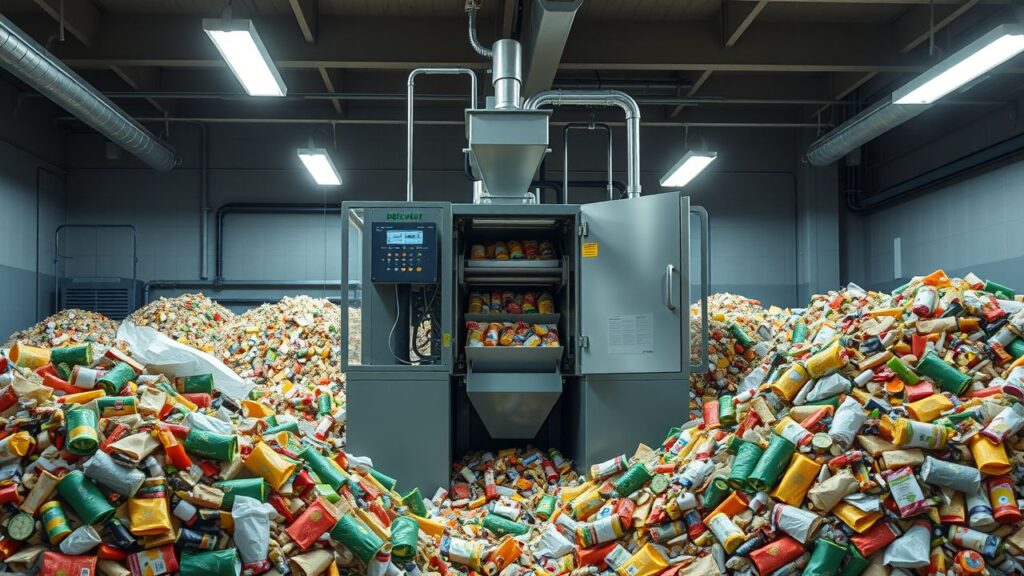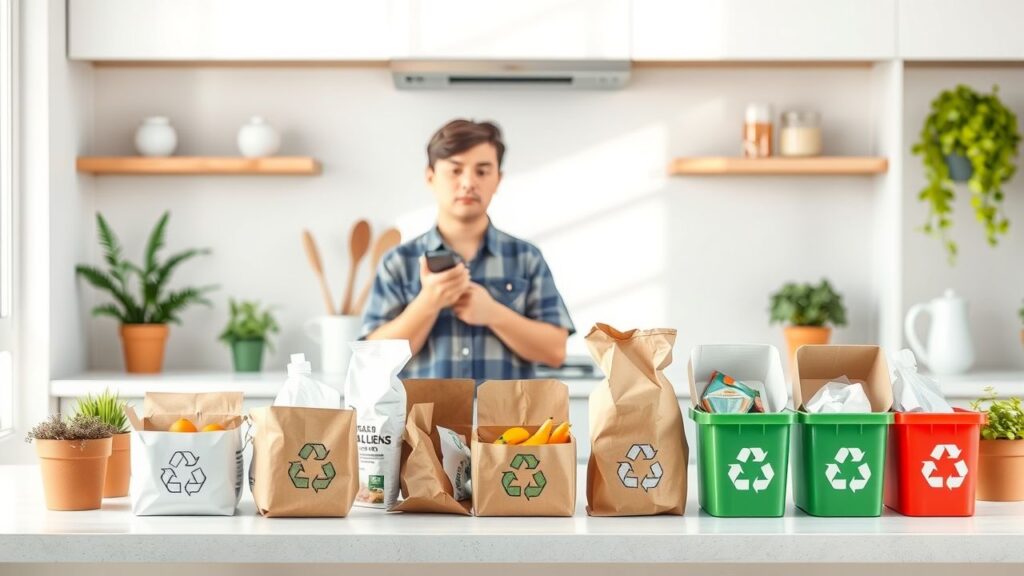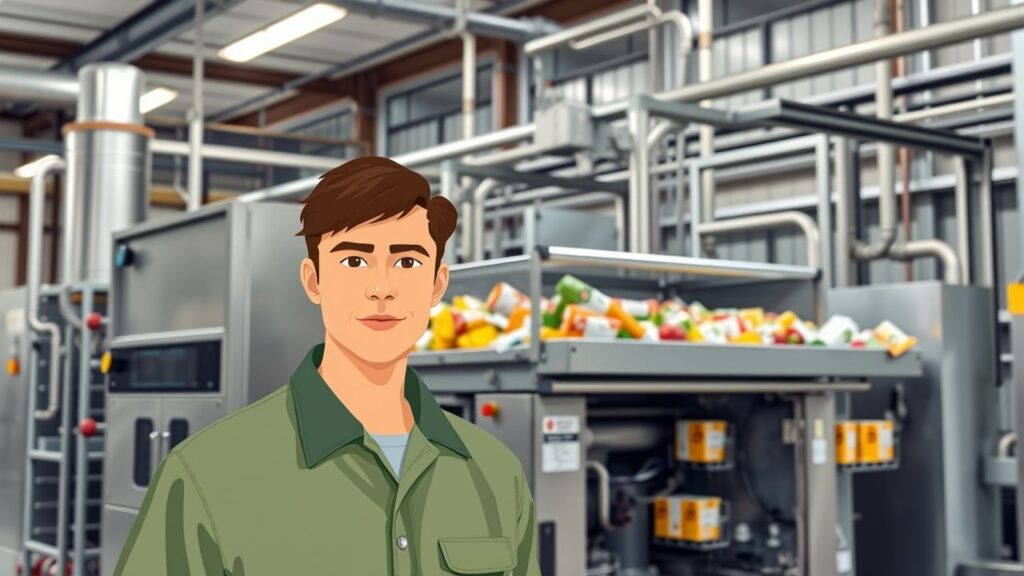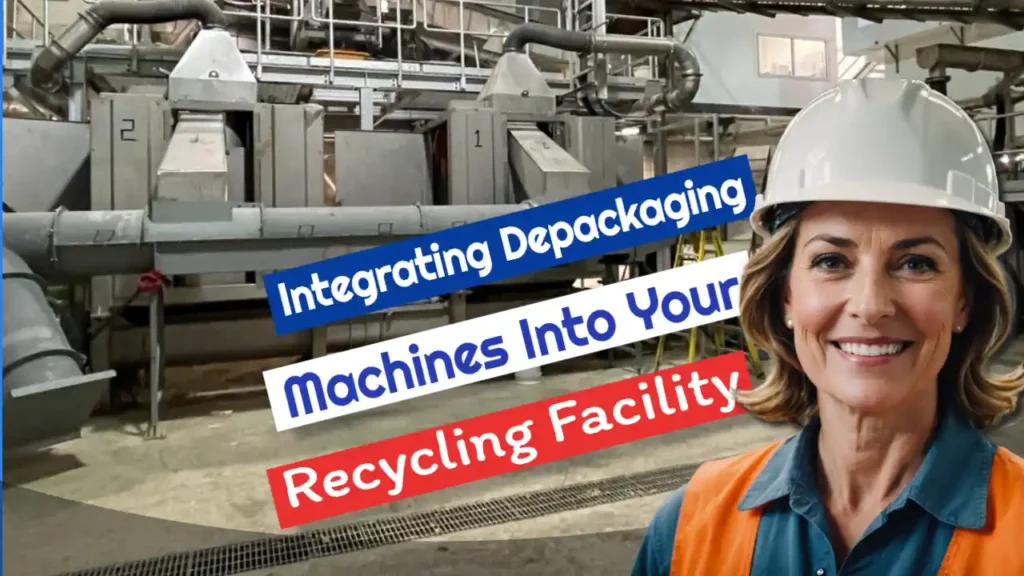Have you ever wondered what happens to food waste mixed with packaging? It’s a big problem. Millions of tons end up in landfills each year. This isn’t just bad for the environment—it’s also costly and inefficient.
Depackaging technology offers a smart solution. Denali, for instance, has introduced systems in various cities to tackle this issue. Their processes help separate food from its packaging efficiently.
In this blog, we will explore how depackaging works and its many benefits—like cost reduction and enhanced food safety. We’ll also look at the challenges involved and how legislation impacts food waste management.
Ready to learn more? Keep reading!
Depackaging Food Waste – Key Takeaways
- Cost Savings and Efficiency: Automated depackaging systems save time and money. They can handle up to 200 tonnes per day, cutting down on labour hours by four to twelve daily.
- Enhanced Food Safety: Reducing human contact lowers contamination risks. This makes the food safer for consumption.
- Compliance with Legislation: Laws like California’s SB 1383 push for better waste management. Following these laws helps reduce methane emissions from landfills.
- Handling Diverse Materials: Depackaging machines manage different packaging types—organic waste (for example kitchen waste), plastics, metals, glass—and ensure clean separation of the food waste content from everything else.
- Boosting Sustainability: Using advanced technology in depackaging cuts landfill use and enhances recycling efforts. When the organic matter is fed into an anaerobic digestion plant energy and a natural fertiliser is made. This supports a cleaner planet and aligns with circular economy and zero-waste goals.

The Depackaging Process
Depackaging food waste separates the edible parts from non-biodegradable packing. This method helps in recycling and reducing landfill waste.
Unpacking the Mechanisms Involved
Depackaging food waste is a complex yet efficient process. It involves several steps that ensure effective separation and proper recycling.
- Mechanical Separation
- Food waste first goes through shredding or crushing.
- This helps break down the packaging materials.
- Turboseparator models like T20 and T30 can handle different capacities from 5 to 50 tons per day.
- Separation of Biomass
- After shredding, biomass is extracted from the waste.
- This biomass can be converted into biogas using anaerobic digesters.
- Non-biodegradable packaging materials are separated and disposed of properly.
- Handling Different Materials
- The system must manage various types of packaging, such as plastics, metals, and glass.
- Ensuring complete removal of contaminants is crucial for the recycling process.
- Operational Efficiency
- Automated depackaging systems like the Turbo Separator reduce downtime.
- They improve operational efficiency by processing up to 200 tons per day with up to 30% contamination.
- Compliance and Safety
- Adhering to regulations like California’s SB 1383 ensures legal compliance.
- Using advanced machines improves employee safety and satisfaction.
These mechanisms make depackaging food waste an essential part of modern waste management strategies.
Benefits of Automated Depackaging Systems
Moving from the inner workings of depackaging, let’s explore the benefits of automated systems. These systems bring efficiency and sustainability to food waste management.
- Cost Reduction: Automated depackaging food waste saves time and money. It can save between four to twelve labour hours per day, per location. This reduces operational costs significantly.
- Enhanced Food Safety: Automation ensures food safety by minimising human contact. This reduces the risk of contamination.
- Operational Flexibility: These systems handle various types of food waste. They process solids, liquids, frozen foods, and semi-solids with ease.
- Improved Employee Satisfaction and Safety: Employees no longer need to do strenuous tasks. Automation reduces repetitive work, enhancing job satisfaction and safety.
- Increased Donations: With less time spent on manual depackaging, donations increase by up to 200%. More edible food reaches those in need.
- Compliance and Reputation Enhancement: Using automated systems helps meet regulations like California’s SB 1383. This boosts an organisation’s reputation for environmental responsibility.
Automated food waste depackaging systems streamline processes and support a sustainable future in waste management.
Key Benefits of Food Waste Depackaging
Food waste depackaging offers many advantages, making it a key technology in waste management. It helps reduce costs while improving safety and efficiency… making operations smoother for everyone involved.
Cost Reductions from Depackaging Food Waste
Using Denali’s depackaging technology can cut costs. Businesses save on landfill fees, compacting waste expenses, and fewer compactor pulls. Waste recycling becomes more efficient with clean packaging materials that are then recycled.
Organic waste like food scraps goes to bioenergy plants, creating potential revenue streams. These savings mean less money spent on maintenance and disposal—leading to greater efficiency.
Denali’s technology helps reduce landfill diversion costs by up to 500% by Depackaging Food Waste
Enhanced Food Safety
Depackaging food waste boosts safety. Automated systems reduce human contact, cutting contamination risks. Secure outdoor receptacles that are cleaned often also help to lower risks.
Mechanised separation ensures compliance with food safety laws and regulations. It reduces unpleasant odours linked to garbage. This makes the environment cleaner for employees and nearby residents.
– Operational Flexibility
Operational Flexibility
Operational flexibility in food waste depackaging systems allows them to handle a wide range of materials. From meat and dairy to prepared and frozen foods, these systems adapt easily.
Scalable solutions fit any store size. SMBs can use the Turbo Separator T20 for varying volumes of food waste, while municipalities benefit from the larger Turbo Separator T42.
This flexibility ensures that businesses remain compliant with regulations such as California’s SB 1383. It promotes efficient processing of mixed food waste—boosting both sustainability and operational efficiency.
Next up: learning about different types of depackaging equipment….
Improved Employee Satisfaction and Safety
Automation in depackaging reduces the risk of injuries, creating a safer workplace. With machines taking over heavy lifting and sorting, employees avoid common hazards like cuts or strains.
Cleaner backroom areas also lead to a more organised working environment.
Labour efficiency gains of four to twelve hours per day per location enhance overall productivity. Workers can focus on tasks that add value instead of manual sorting—boosting morale and job satisfaction.
Automated systems help create an atmosphere where safety and efficiency go hand in hand.
“Automated systems free up workers for more meaningful tasks,” says John Doe, waste management expert at Republic Services.
Compliance and Reputation Enhancement
Satisfied employees can lead to better compliance. A good waste depackaging system keeps workers safer and happier, boosting moral.
Sticking to local and national food waste rules helps avoid fines. It also strengthens the company’s name in the public eye. Companies that follow regulations show they care about the environment.
This boosts their reputation and can lead to more profits.
Effective waste management shows responsibility. Meeting standards helps earn trust from customers and partners alike. Using biowaste correctly cuts down on methane emissions, which is great for both business and the planet.
Types of Depackaging Equipment
Depackaging equipment comes in different types to handle various kinds of food waste. Some machines work well with solid and semi-solid foods, while others excel at managing liquids and frozen items.
Systems for Solid and Semi-Solid Foods
Systems for solid and semi-solid foods use advanced technology to separate packaging from food waste. For example, the Scott Equipment depackager uses rotating paddles for efficient separation.
The Tiger HS640 handles both wet and dry processing, ensuring high recovery rates of 90-97%.
Flexibility in handling different types of food waste is key, says a specialist at DODA.
Food Waste Depackaging systems make it easier to recycle organics. They keep contaminants out and enhance purity levels—in some cases, exceeding 99%. This efficiency helps reduce costs and improves environmental impact through better recycling practices.
Liquids and Frozen Foods Handling Equipment
Handling liquids and frozen foods presents unique challenges. Denali is introducing technologies that can remove packaging from these types of food efficiently. These machines use advanced methods to separate packaging from the contents without contamination.
Liquid handling equipment works well with items like soups, sauces, and dairy products. They ensure clean separation while maintaining food safety standards. For frozen foods, such as vegetables or meats, specialised machinery thaws them safely before removing the packaging.
This process helps in maximising materials for reuse and reducing waste sent to landfills.
Challenges in Food Waste Depackaging
Depackaging food waste poses some tough problems. Handling different packaging materials and making sure all contaminants are fully removed can be tricky.
Handling Diverse Packaging Materials
Handling diverse packaging materials poses a big challenge in food waste depackaging. Over 80% of food waste in the U.S. is wrapped or contained in various types of packaging, which can be tough to deal with.
Items like plastics, metals, and mixed materials demand specific methods to separate them from the food waste.
Machines like the Drycake Twister Depackager and Separator are crucial here. This system can handle contamination from different packaging types—whether it’s plastic, metal, or cardboard. Effective solutions for dealing with these materials ensure minimal contaminant risk and result in safer compost for sustainable agriculture practices.

Ensuring Complete Removal of Contaminants
Ensuring complete removal of the many and varied contaminants in food waste high efficiency depackaging is vital. The Drycake Twister Depackager and Separator achieves over 99% clean organics. With the addition of a Seditank Unit it filters out plastics, metals, and other waste effectively.
High contamination levels can easily reach 30%, making this process crucial.
Mechanical depackaging must separate and sort the waste thoroughly. This step is not only essential to avoid clogging up anaerobic digestion tanks but when used before windrow or in-vessel composting improves compost quality by keeping harmful materials out of the mix. Advanced depackaging technology helps reduce landfill waste and creates cleaner organic products, aiding the circular economy.
Next, we’ll discuss food waste categories suitable for depackaging…
Food Waste Categories Suitable for Depackaging
Certain types of food waste are ideal for depackaging. Many industries produce food scraps that can be efficiently processed with this technology….
1. Meat Processing Industry
Food loss in the meat sector is a big problem. About 23% of meat produced gets wasted, and 64% of this waste happens when people eat it at home or in restaurants. Depackaging machines are available that process all kinds of meats, from trimmings to fully packaged products.
It is not often known, but the abattoir industry uses depackaging machines.
Automated depackaging systems can make recycling food waste easier and safer. They separate food from packaging quickly, reducing manual work. This helps keep workers safe and happy, while also cutting costs for businesses by recycling materials correctly.
Next up: Dairy Industry…
2. Dairy Industry
Depackaging dairy waste covers items like milk, yoghurt, sour cream, and eggs. These products often come in various packaging types that need efficient processing. Denali excels in this area by avoiding Styrofoam since it complicates recycling.
Mechanised depackaging boosts labour efficiency. This means workers spend less time on tedious tasks and more on productive work. The result? Lower costs for waste disposal and fewer landfill needs…
leading to better sustainability!
3. Food Preparation
After tackling dairy waste, let’s look at prepared food waste. This includes items like sandwiches, salads, soups, and rotisserie chicken. These foods often come in varied packaging which can be challenging to handle.
Denali, for example, offers solutions for this problem. Their systems turn prepared food waste into semi-liquid biomass through mechanical separation. This processed biomass can then be used for things like compost soil or anaerobic digestion to produce renewable energy.
Using automated depackaging systems improves labour efficiency. Workers spend less time on mundane tasks and focus more on productive activities—leading to higher job satisfaction and safety standards as they avoid handling sharp objects or heavy loads manually.
In addition to these advantages, proper handling of prepared food waste boosts compliance with regulations and helps enhance the company’s reputation for sustainability efforts.
4. Bakery and Grocery Departments
After discussing the prepared foods, let’s move on to bakery and grocery departments. Denali processes a wide range of bakery waste like cakes, bread, cookies, pasta, and cereal.
This repurposing helps turn pre-consumer biscuit and bakery waste into animal feed, cutting down food waste.
The grocery category includes fresh produce, canned goods, rice, candy, and more. Depackaging machines handle these diverse items efficiently. They reduce microplastic contamination and minimise environmental impact.
These solutions help make food waste management more sustainable—boosting both compliance with regulations and overall operational efficiency.
The Role of Legislation in Promoting Food Waste Depackaging
The Role of Legislation in Promoting Food Waste Depackaging: New laws like California’s SB 1383 push for better food waste handling. These rules help cut down landfill use and boost recycling efforts…
Find out more about their impact!
California’s SB 1383 and its Impact
California’s SB 1383 mandates a 75% cut in organic waste disposal by 2025. This law aims to reduce methane emissions from landfills. Businesses that create over one tonne of food waste must divert it away from incineration or landfilling.
Successful depackaging can help firms comply with this rule—saving costs and boosting sustainability. These efforts play a vital role in organics recycling and zero-waste goals, enhancing reputations and aligning with green energy initiatives.
Industrial Depackaging Solutions for Boosting Efficiency and Sustainability
Industrial depackaging solutions improve waste management. They also help reduce carbon footprints. Machines like screw presses and trommel screens separate packaging from food waste efficiently.
This separation stops microplastic pollution—keeping recyclates clean for reuse.
Many firms, including Doppstadt and Mavitec, make these machines. Their equipment handles various types of food waste—from grocery stores to frozen foods. These systems enhance efficiency and support goals set at COP26 for net-zero emissions by providing cleaner biowaste for energy production through biogas digesters.
Conclusion: The Future of Food Waste Management Through Depackaging
Depackaging food waste is a crucial step toward a sustainable future. With advanced technology, the process becomes more efficient and cost-effective. This reduces landfill use and boosts recycling efforts.
By adopting these solutions, businesses can comply with regulations and enhance their reputation—paving the way for a cleaner planet.
FAQs – Depackaging Food Waste
1. What is depackaging food waste?
Depackaging food waste involves removing packaging from discarded food items to recycle materials and reduce solid waste.
2. How does depackaging contribute to zero waste goals?
By separating recyclable materials from food wastes, it helps in achieving zero waste by ensuring that more recyclables are processed instead of ending up in landfill.
3. Can depackaged food waste be used for other purposes?
Yes, source-separated organics (SSO) can be turned into compost or bioenergy, reducing reliance on chemical fertilisers and enhancing sustainability.
4. What equipment is used in the depackaging process?
Common tools include augers, compactors, and extruding machines which help in efficiently separating the packaging from the organic content.
5. How do companies like Walmart U.S., Sam’s Club, and Walmart Inc. benefit from these solutions?
These companies improve transparency and efficiency in their recycling processes while mitigating environmental impact through better management of their solid wastes.
6. Are there any challenges associated with depackaging food waste?
Challenges include managing microplastics contamination and maintaining high compressive strength during transportation to recycling centres or disposal sites.
References
- https://thinkviably.com/resource-library/unpacking-food-waste-opportunities-across-business-types/
- https://www.wwdmag.com/what-is-articles/article/33015283/what-is-food-waste-depackaging (2023-11-17)
- https://elegantlyorganic.co.uk/depackaging-equipment-for-the-food-industry/
- https://waste-technologies.co.uk/food-waste-depackaging-systems-for-sustainability-and-microplastic-reduction/
- https://thinkviably.com/resource-library/what-is-food-waste-depackaging/ (2024-04-29)
- https://www.denalicorp.com/services/depackaging/
- https://www.fpe.net.au/depackaging-machine/ (2023-10-20)
- https://www.tecnofer.biz/en/depackaging/
- https://www.biocycle.net/food-waste-depackaging-systems/ (2019-07-10)
- https://thinkviably.com/resource-library/costs-of-not-depackaging-food-waste/
- https://www.mdpi.com/2071-1050/13/11/6227
- https://wastersblog.com/101429/food-waste-depackaging-methods/ (2022-06-19)
- https://wastersblog.com/102757/pre-consumer-biscuit-and-bakery-waste-depackaging/
Discover more from IPPTS Depackaging Equipment Insights
Subscribe to get the latest posts sent to your email.








